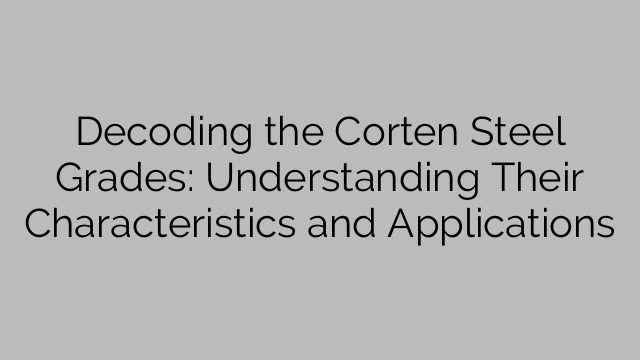Corten steel was initially developed for its superior corrosion resistance properties. It contains a combination of copper, phosphorus, chromium, nickel, and other elements, which form a protective oxide layer on its surface when exposed to the atmosphere. This layer acts as a shield, preventing the steel from further corrosion, and gives it its distinct rusty appearance.
Different grades of Corten steel have varying compositions, which influence their mechanical properties and applications. Let’s delve into some of the commonly used grades and their characteristics:
1. Corten A: This grade is a weathering steel that offers high corrosion resistance. It is primarily used for architectural structures, such as bridges, buildings, and sculptures, as it develops a stable rust-like patina over time. Corten A is known for its toughness and durability, making it suitable for outdoor applications.
2. Corten B: Corten B is a high-strength, low-alloy steel grade with added phosphorus, which enhances its corrosion resistance. This grade is commonly used in structural applications, such as bridges and buildings, where higher strength is required. Its ability to withstand extreme weather conditions makes it a popular choice for outdoor structures.
3. Corten S355J2W: S355J2W is a Corten grade with improved atmospheric corrosion resistance. It has a higher yield strength and tensile strength compared to Corten A and B, making it suitable for heavy-duty applications such as load-bearing structures and machinery.
4. Corten A588: A588 is a high-strength, low-alloy Corten steel grade that exhibits improved corrosion resistance over traditional carbon steel. This grade is commonly used in outdoor applications, such as bridges, buildings, and marine environments, where exposure to harsh elements is unavoidable.
Understanding the characteristics of different Corten steel grades is crucial in determining which grade is suitable for your specific application. Factors to consider include the level of corrosion resistance required, the strength needed, and the expected exposure to weather conditions.
In addition to its aesthetic appeal and durability, Corten steel is also an environmentally friendly choice. Its long lifespan and low maintenance requirements make it a sustainable alternative to traditional steel. By choosing Corten steel, you contribute to reducing carbon emissions associated with frequent maintenance and replacement.
In conclusion, Corten steel offers a range of grades, each with unique characteristics and applications. Whether you need an architectural structure, a load-bearing structure, or a material resistant to harsh weather conditions, there is a Corten steel grade that suits your requirements. Understanding these grades and their properties will help you make an informed decision when incorporating Corten steel into your project.
[ad_2]

